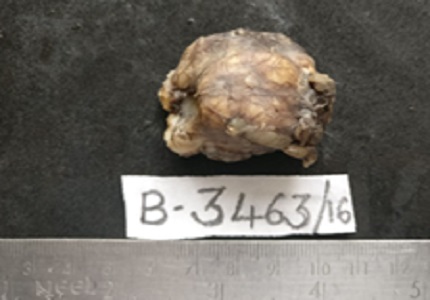Cat scratch disease - a case report
Abstract
Cat scratch disease is benign self-limiting infectious disease caused by B.Henselae. It can occur world-wide with no racial or sex predilection. Cats are the major reservoirs. Transmission can occur through biting, scratching and licking. Patients present with regional lymphadenopathy. A 17-year-old male presented with a single swelling in the inguinal region of 15 days duration. It was gradually increasing in size. The swelling measured 6cm * 5cm, soft to firm in consistency, non-tender. The mobility was restricted. Fine needle aspiration cytology was performed which was diagnosed as granulomatous lymphadenitis. The swelling was excised and sent for histopathological examination. Histopathologically, a final diagnosis of Cat-scratch lymphadenitis was made. Cat-scratch Disease is a self-limiting illness in an immuno-competent host. The associated lymphadenitis is mainly solitary and unilateral. Although it is not a unique diagnosis, Cat-scratch disease is required to implement appropriate and targeted antibiotic therapy.
Downloads
References
2. Bass JW, Vincent JM, Person DA. The expandingspectrum of Bartonella infections: II. Cat-scratch disease. Pediatr Infect Dis J. 1997 Feb;16(2):163-79. [PubMed]
3. Dolan MJ, Wong MT, Regnery RL, Jorgensen JH, Garcia M, Peters J, Drehner D. Syndrome of Rochalimaeahenselae adenitis suggesting cat scratch disease. Ann Intern Med. 1993 Mar 1;118(5):331-6. [PubMed]
4. Anderson B, Sims K, Regnery R, Robinson L, Schmidt MJ, Goral S, Hager C, Edwards K. Detection of Rochalimaeahenselae DNA in specimens from cat scratch disease patients by PCR. J Clin Microbiol. 1994 Apr;32(4):942-8.
5. Nelson, C. A., Saha, S., & Mead, P. S. (2016). Cat-Scratch Disease in the United States, 2005-2013. Emerging Infectious Diseases, 22(10), 1741-1746. doi:10.3201/eid2210.160115. [PubMed]
6. Wear DJ, Margileth AM, Hadfield TL, Fischer GW, Schlagel CJ, King FM. Cat scratch disease: a bacterial infection. Science. 1983 Sep 30;221(4618):1403-5.
7. Margileth AM. Cat-scratch disease: non-bacterial regional lymphadenitis. The study of 145 patients and review of literature. Pediatrics1968;42:803-18. (DOI: 10.1111/j.1834-7819.1985.tb05830.x)
8. WINSHIP T. Pathologic changes in so-called cat-scratch fever; review of findings in lymph node of 29 patients and cutaneous lesions of 2 patients. Am J Clin Pathol. 1953 Oct;23(10):1012-8. [PubMed]
9. Carithers HA. Cat-scratch disease. An overview based on a study of 1,200 patients. Am J Dis Child. 1985 Nov;139(11):1124-33.
10. Miller-Catchpole R, Variakojis D, Vardiman JW, Loew JM, Carter J. Cat scratch disease. Identification of bacteria in seven cases of lymphadenitis. Am J SurgPathol. 1986 Apr;10(4):276-81. [PubMed]
11. Cotter B, Maurer R, Hedinger C. Cat scratch disease: evidence for a bacterial etiology: a retrospective analysis using the Warthin-Starry stain. Virchows Arch APatholAnatHistopathol. 1986;410(2):103-106.
12. KorbiS, Toccanier MF, Leyvraz G, Stalder J, Kapanci Y. Use of silver staining (dieterlé'sstain) in the diagnosis ofcat scratch disease. Histopathology. 1986 Oct;10(10):1015-21. [PubMed]



 OAI - Open Archives Initiative
OAI - Open Archives Initiative


